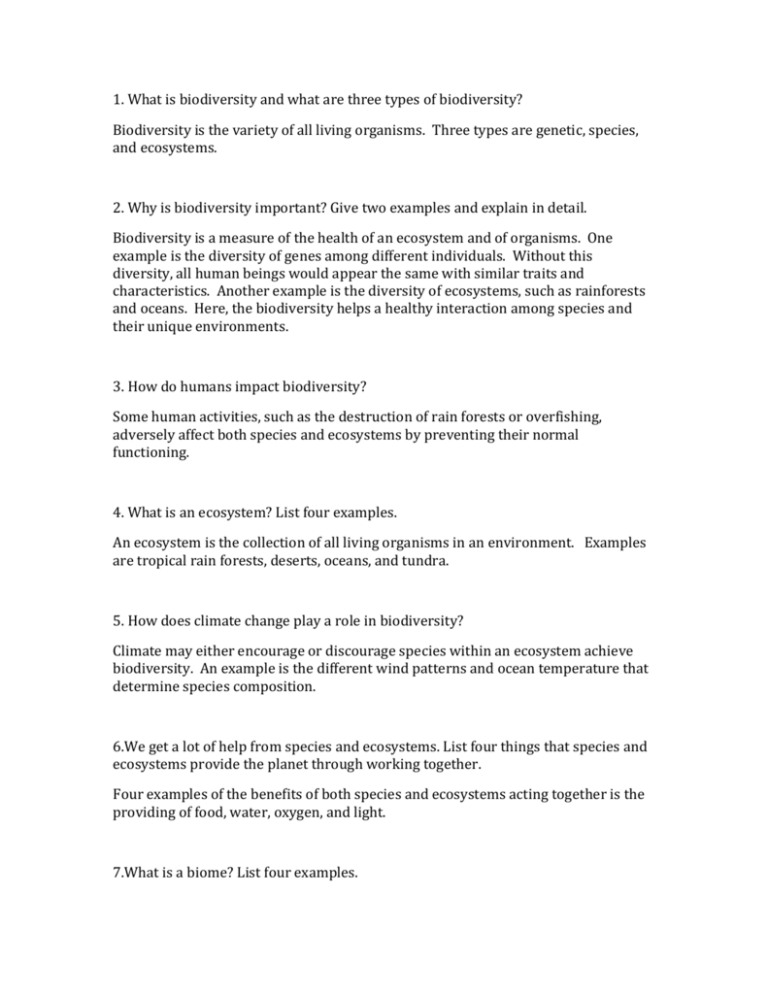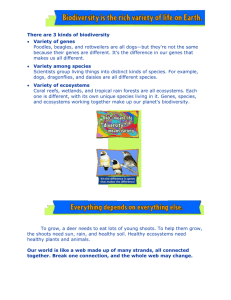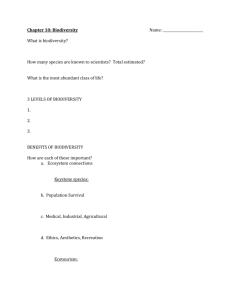Science Short Answers
advertisement

1. What is biodiversity and what are three types of biodiversity? Biodiversity is the variety of all living organisms. Three types are genetic, species, and ecosystems. 2. Why is biodiversity important? Give two examples and explain in detail. Biodiversity is a measure of the health of an ecosystem and of organisms. One example is the diversity of genes among different individuals. Without this diversity, all human beings would appear the same with similar traits and characteristics. Another example is the diversity of ecosystems, such as rainforests and oceans. Here, the biodiversity helps a healthy interaction among species and their unique environments. 3. How do humans impact biodiversity? Some human activities, such as the destruction of rain forests or overfishing, adversely affect both species and ecosystems by preventing their normal functioning. 4. What is an ecosystem? List four examples. An ecosystem is the collection of all living organisms in an environment. Examples are tropical rain forests, deserts, oceans, and tundra. 5. How does climate change play a role in biodiversity? Climate may either encourage or discourage species within an ecosystem achieve biodiversity. An example is the different wind patterns and ocean temperature that determine species composition. 6.We get a lot of help from species and ecosystems. List four things that species and ecosystems provide the planet through working together. Four examples of the benefits of both species and ecosystems acting together is the providing of food, water, oxygen, and light. 7.What is a biome? List four examples. A biome is a home of geographically and climatically similar areas. Examples are land, sea, air, and underground biomes. 8. How can biodiversity be protected? List some ways that our species as a whole can protect it. Our species can protect biodiversity by instituting rules and regulations against damaging environment and species practices. This may include reducing carbon footprints and outlawing poaching. 9. What can you do as an individual to protect and preserve biodiversity and our environment? List four things that you can do to conserve. Examples of activities individuals can do to protect biodiversity is conserving energy in our homes, recycling, reducing waste, and using sustainable forms of energy. 10. What is a “ carbon footprint”? Explain and give an example. Carbon footprint is the residue or waste that human’s produce through their activities, such as the production of carbon monoxide emissions when driving or using machinery. 11. Describe the difference between an endangered species and an extinct species? Explain and give an example for each. An endangered species is being threatened with extinction, while an extinct species has already lost its number completely. An example of an endangered species is the white rhino, while the dodo bird is an extinct species 12. What are five reasons for extinction? Give examples and details. Reasons for extinctions are human hunting, climate change, overfishing, predators, and lack of food. Examples are is the farming of pacific salmon and polar species being threatened as a result of global warming. 13. There are many organizations out there that protect or support endangered species and biodiversity. Give an example of one and explain what they do. Greenpeace is an organization that protects both species and natural environmental landmarks through activism and education. 14. Why should we protect endangered species? They are our only link to the past. They also allow us to study own species and those of closely related species to those that are endangered. Diversity benefits us all. 15. What is the cause of the sixth mass extinction? Explain in detail. The sixth mass extinction is the widespread, ongoing mass extinction of species during the Holocene period. This includes the mass extinction of animals and plants during the modern period as a result of human activities and abuses. Many of these extinctions are as yet un-documented. Therefore, there may be many more than are currently known. 16. How does overpopulation affect biodiversity? Explain and give an example. Overpopulation leads to an unsustainable competition for resources. An example would be the lack of food to feed a growing population, such as those seen in impoverished third world countries. 17. Explain overexploitation and give an example. Overexploitation is the practice of using resources more than they were intended to. This leads to a draining of resources and an exhaustion of future supplies. An example is over-farming of arable land. 18. How does consumerism play a role in the sixth mass extinction? Human wants and desire create an unending need for consumer goods that are produced from the environment. This puts pressure on exploiting species and natural resources. 19. What does it mean to recycle and how is it beneficial to our environment? Recycling reuses resources for future use. It allows us to protect and conserve our environmental resources. 20. How does an ecosystem work? Describe the cycle that takes place in an ecosystem. Ecosystems work by a cycle effect, where organisms and their environment go through dynamic change from birth to death. Each step along this process feeds the next step, creating a new self-sustaining cycle. An example is the return of carbon and other building blocks of life to the ground upon the passing of organisms. This allows for perpetual energy use and life-creation.








